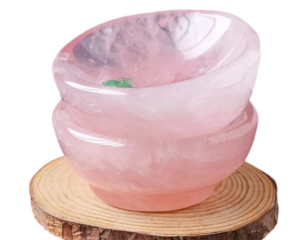Cleavage is the tendency of a crystallised mineral to break in certain definite directions, giving more or less smooth surfaces.
- This splitting is due to weak cohesive forces present in a mineral along different directions and is also related to the form and crystal structure of the mineral.
- A crystal may cleave in more than one direction.
- A crystal which cleaves in one direction will cleave equally well in every other parallel plane.
- Planes of cleavage are always planes of the crystal structure and therefore are parallel to possible crystal faces.
- Cleavage is due to the regular arrangement of atoms. Hence, there is no cleavage in an amorphous substance.
Cleavage in a crystal is described by the direction of cleavage, the number of directions in any single crystal, the ease of splitting and the quality of the cleavage surface obtained.
Cleavage is said to be:
- Octahedral, when it is parallel to octahedral faces or planes of cubic crystals (diamond).
- Prismatic, when it is parallel to the prism face (spodumene).
- Basal, when they are parallel to the basal pinacoid (topaz).
- Rhombohedral, when they are parallel to the rhombohedral faces (calcite).
Types of cleavage can be described as:
- Perfect as in mica, topaz, or calcite.
- Easy but imperfect as the octahedral cleavage in fluorite.
- Easy and perfect as the rhombohedral cleavage in calcite.
- Difficult as in peridot.
- Perfect but difficult as the octahedral cleavage in diamond.
- Difficult and imperfect as the basal cleavage in beryl.
For identifying cleavage:
- On the surface observe some minutely stepped flat planes, or a wavy pattern.
- The surface will show a pearly luster because of its laminated nature.
- Iridescent colours develop within the stone or on its surface along cleavage directions or cracks. This is caused when a thin film of air penetrates into the flaws or cracks. Spectral colours are seen in fluorite, topaz and calcite.
- In cut specimens smooth parallel cracks or directional cracks are indications of cleavage directions. They may or may not exhibit iridescence.
Too easy a cleavage is not desirable, because while cutting or polishing, the stone may level flaws or may even crack. Hence a good gem cutter selects the type of cut with respect to the cleavage directions. Cleavage is useful in cleaving rough stones such as diamonds, so as to improve yield and costs.
Cleavage Chart
| Gemstone | No. of Directions | Gemstone | No. of Directions |
|---|---|---|---|
| Apophyllite | 1 | Fluriote | 4 |
| Apatite | 2 | Iolite | 1 |
| Calcite | 3 | Kyanite | 1 (+1 parting) |
| Diamond | 4 | Orthoclase Feldspar | 2 |
| Diopside | 2 | Sillimanite | 1 |
| Dioptase | 3 | Sodalite | 6 |
| Epidote | 1 | Spodumene | 2 |
| Euclase | 1 | Topaz | 1 |
Parting (pseudo cleavage) – Some crystals can be divided in two, along a plane of weakness known as a parting plane which is along a twin plane.
- Parting is usually due to lamellar twinning, as in labradorite feldspar.
- Parting is possible only along definite planes in twinned crystals and not along every parallel plane.
- A crystal may exhibit both cleavage and parting, as in corundum, (parting parallel to the rhombohedral face and cleavage parallel to the basal pinacoid) and labradorite (parting along the lamellar plane and two other directions of cleavage).
Fracture – The surface of a mineral obtained when it breaks in directions other than cleavages or parting is known as fracture. Fracture occurs in random directions mostly due to a sharp impact.
Types of fractures are:
- Conchoidal (shell like) as a smooth break with concentric rings. This is the most common form of fracture, particularly well seen in glass, quartz and garnet.
- Splintery – has a fibrous appearance similar to a break on wood with the grain. E.g. nephrite, jadeite and ivory.
- Granular – Sugary appearance common to crystalline aggregates.
- Even – smooth break, but does not show the stepped structure as in cleavage e.g. diamond.
- Uneven – a rough and irregular fracture. Any rock or mineral can exhibit this.
Fracture surfaces and the lustre observed on them are important from the point of identification. E.g. Rough moonstone can be identified from rough chalcedony of the same quality by the lustre on the fracture surfaces. Moonstone will have a pearly lustre while chalcedony will exhibit a waxy to dull lustre.



























Leave a Reply
You must be logged in to post a comment.